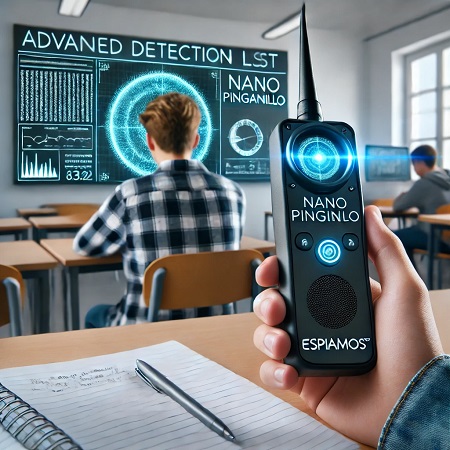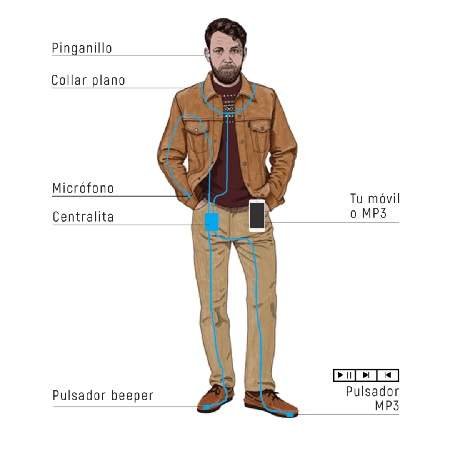Detecting an e-earphone or nano-earphone in an exam is essential to prevent academic fraud in educational environments. These tiny devices are virtually invisible to the naked eye, allowing students to receive external information without raising suspicion. Therefore, specialized detection technology is key to identifying these cheats and maintaining the integrity of exams.

Table of Contents
- What is an earpiece or micro earpiece?
- How do these devices work during exams?
- Effective methods for detecting an epipinganillo
- Electromagnetic field detectors: a key tool
- Metal detectors for locating earring rings
What is an earpiece or micro earpiece?
An earpiece , also known as a micro earpiece , is a tiny device used to receive information in a hidden manner during exams or tests. Its small size, which can be smaller than a lentil, makes it almost imperceptible when inserted into the ear canal. This device has no internal electronic components or battery, as it works as a simple magnet that receives signals through an electromagnetic field generated by an induction collar.
Due to its small size and passive operation, the micro earpiece is one of the most difficult devices to detect. The combination with the inductive collar, which connects to a mobile phone or similar device, allows the user to receive information discreetly during a test.

How do these devices work during exams?
The way a micro earpiece or epinganillo works is simple, but highly effective. The device itself is a small magnet that is placed inside the ear. For this magnet to work, it needs to be connected to an inductive necklace that generates an electromagnetic field around the user's neck. This electromagnetic field transmits the vibrations that the ear magnet converts into sound, allowing the student to receive the information in a hidden manner.
The hearing collar is linked to a mobile phone or audio player via Bluetooth or a cable, allowing the student to listen to messages or instructions from outside. Although the hearing device does not emit visible signals, the hearing collar and mobile device are the elements that can be detected with the appropriate tools.
Effective methods for detecting an epipinganillo
Detecting a hidden hearing device such as an earpiece requires the use of advanced technology, as these devices do not emit frequencies or signals of their own. However, there are several effective techniques for detecting them:
Visual and behavioral inspection
Although earplugs are extremely small, in some cases careful visual inspection or observation of suspicious behavior can alert to their use. Examiners may notice repetitive movements toward the ear, attempts to adjust the device, or excessive nervousness in the student. Although this method is not foolproof, it can be a first step toward suspecting the presence of a concealed device.
Using electromagnetic field detectors
Electromagnetic field detectors are a fundamental tool for detecting an earpiece or nano earpiece. Since these devices work thanks to a field generated by an inductive collar, the best way to locate them is by identifying electromagnetic emissions. An electromagnetic field detector It can pick up fluctuations in the field generated by the inductive collar, making it easier to detect a device in use without the need for an invasive physical inspection.
These detectors are especially useful in detecting hidden devices that do not emit active signals like Bluetooth or Wi-Fi, but instead rely on electromagnetic fields to operate. By detecting these fields, it is possible to identify the location of the inductive collars that are transmitting information to the earpiece, allowing the personnel in charge to precisely locate the area where it is being used.
Using frequency detectors to identify the linked device
Although the earpiece or nano earpiece itself does not emit radio frequency signals, the device that controls it (usually a mobile phone or audio player) does. Therefore, one of the most effective ways to detect the use of these devices is by using a frequency detector that monitors GSM, Bluetooth or Wi-Fi waves.
When the mobile device connected to the collar is transmitting information, the frequency detector will pick up the signal and issue an alert, indicating the presence of a communication device. This detection method is primarily used to identify the external equipment that is sending the information to the student, such as the mobile phone or a wireless transmission unit, and is very effective in most scenarios.
Detection of ear rings with metal detectors
Another effective technique for detecting an earpiece or nano earpiece is through the use of a metal detector . Although the earpiece itself has no electronic components, it is made of metallic materials that can be detected by devices designed to find small metal objects. This type of detector is especially useful in cases where students hide the device deep in the ear canal.
The metal detector not only locates the earpiece, but can also identify other electronic devices that the student is using, such as the induction collar or associated accessories. This allows for a more complete and accurate detection, covering both the electromagnetic and physical aspects of the devices used for fraud.
As earpieces evolve into smaller, more discreet versions, the combined use of metal detectors and electromagnetic field detectors becomes essential to ensure that all hidden devices are located.
Conclusions on the detection of epiganillos and nano-epinganillos
The evolution of fraud devices, such as the earpiece and nano-earpiece , has made their detection more difficult in academic settings. However, with advances in detection technology, it is now possible to effectively identify these devices. Electromagnetic field, metal and frequency detectors offer a comprehensive solution for locating hidden devices, such as the nano-earpiece , that do not conventionally emit active signals.
Using a combined approach to detection, employing technologies such as the 3HECA Mini detector , allows educational institutions to ensure the integrity of exams, reducing the chances of fraud. As cheating devices become more sophisticated, those responsible for academic security must stay ahead of the curve, using the most advanced tools available.
Finally, proper staff training is key to ensuring that detectors are used optimally. With the right training and the right equipment, the detection of earpieces and nano-earpieces is more accessible and effective, thus protecting fairness and justice in examinations.
Frequently Asked Questions (FAQ) about the detection of epiganillos and nano-epinganillos
Is it possible to detect a nano earpiece without a specialized detector?
No, due to the extremely small size of the nano earpiece and its metallic nature, it is not possible to detect it without the use of specialized equipment. The use of metal detectors or electromagnetic field detectors is recommended for its identification.
What type of equipment is used to detect epirings?
To detect earplugs , electromagnetic field detectors , metal detectors , and in some cases, frequency detectors are used if the device uses signals such as Bluetooth or Wi-Fi.
Is it legal to use metal detectors in exams?
The use of metal detectors in exams is completely legal, as long as institutions inform students in advance about the implementation of additional security measures. This ensures a fair and transparent exam environment.
What is the difference between a nano earpiece and an epi-earpiece?
The term nano-earpiece usually refers to an extremely small version of an earpiece, which is difficult to detect due to its size. On the other hand, epinganillo can refer to any type of cheating device that uses inductive or signal-transmitting technology to receive information, whether nano or otherwise.
How can the use of earplugs during examinations be prevented?
The best way to prevent the use of earpieces is to implement robust security measures, such as the use of metal, electromagnetic field and frequency detectors, along with clear policies prohibiting the use of electronic devices during exams.






 WhatsApp
WhatsApp Telegram
Telegram


